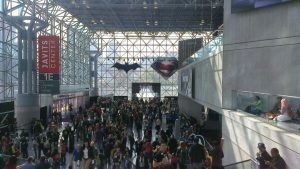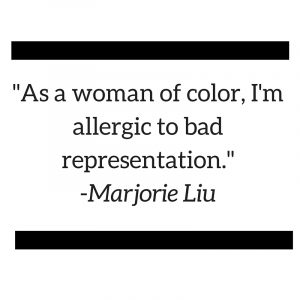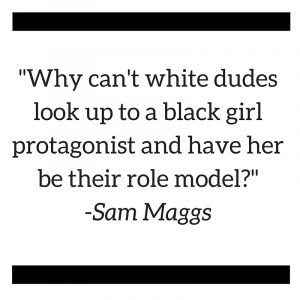This past weekend, we noticed an unusual number of superheroes, cosplayers, and characters from our favorite TV shows flooding the subways, buses, and streets of New York City. Did we unknowingly fall into an alternate universe?
Turns out that it was just New York Comic Con, the annual pop culture phenomenon dedicated to comics, graphic novels, anime, video games, movies, and television. The first convention was held in 2006 and it has continued to grow steadily over the past several years, bringing an ever-growing number of comics and pop-culture fans to New York City. And not only has Comic Con continued to grow, but so has programming dedicated to issues of diversity and diverse creators. We were lucky enough to get a pass for LEE & LOW staff. Below, three staff members share their highlights from the show:

Keilin, Marketing and Publicity Associate
Oh Comic Con. What a crazy event to go to, but definitely worth every minute!
I went to a Geeks of Color Meetup, hosted by Diana Pho (editor, Tor Books), and featuring Shelley Diaz (editor, School Library Journal), and author Melissa Grey (The Girl At Midnight). It was great to mingle with other “geeks” and to get to know Diana and Shelley.

Sailor Moon at the Geeks of Color Meetup
The greatest thing about the Meetup was seeing the diversity in the room. There was one group of people that I joined that was talking about the new Star Wars movie coming out, and it didn’t matter that we were all from different backgrounds because we all could geek out about something we were all collectively excited for. Diana often hosts these types of meetups for people of color, and if anyone is interested, you can contact her on her website, Beyond Victoriana.
After the Geeks of Color Meetup, I booked it over to the Asian American Comics and Creators panel, which unfortunately was full. On the positive side, that just meant that there was a full house to participate in a discussion on Asian Americans in the comic book industry. While the depictions of Asian Americans in comic books has improved, there is more that can still be done.
The thing I like most about conventions like these is that it shows you the wide spectrum of people within fandoms, whether it’s seeing a black Wonder Woman or an Asian Peggy Carter. Nerding out is for everyone!
Rebecca, Marketing and Publicity Assistant
Thanks to things like the We Need Diverse Books campaign, diversity has been on people’s minds more than ever before. Last year, we saw one of the most diverse television seasons we’ve gotten in a while. It’s no surprise that diversity in comics and geek culture was on a lot of people’s minds at New York Comic Con! I attended 4 panels focused on various aspects of diversity at the show this year.

The “Chicks Kick Ass” panel
At the Pushing Boundaries panel, there was a discussion about representation. Author Marjorie Liu spoke about the burden that authors of color often face when they are the only ones representing entire cultures. They have to make sure that their characters are “perfect” and not stereotypical; however, trying to tell a “perfect” story gets in the way of an authentic narrative. This is the danger of a single story: one person from a marginalized or underrepresented group can’t represent everyone from that group.
Some of the other panelists, like Jeremy Whitley, the creator of Princeless, spoke about using their work to fill a need. Jeremy Whitley’s daughter is a person of color, so he wanted to write a comic where a young black girl would see herself as a princess that went on adventures. Geek Out was started as a space for LGBT+ fans of comics. At one point in the discussion, the panelists spoke about bad representation. Is bad representation better than no representation? There was no clear answer, as one panelist said he preferred bad representation to none at all. But author Marjorie Liu said, “As a woman of color, I’m allergic to bad representation.”
The pervading feeling at the “Geeks of Color: Harder, Better, Faster, Stronger” panel was that while people are paying more attention to diversity and things with diverse content, we still have a long way to go. Industries need to diversify from within as well as to seek out diverse creators. Diversity naturally happens when there are a variety of people creating things.
Authors Melissa Gray, Daniel Jose Older, Sara Raasch, and Kim Harrison discussed what made the protagonists of their novels “kick ass.” Melissa Grey (The Girl at Midnight) discussed how female characters are never allowed to be unlikable, like male characters often are. They’re usually expected to be “nice.” Daniel José Older wants his books to show the diversity in Brooklyn, because a book should be like a friend and tell you the truth.
At the Women in Geek Media panel, the panelists encouraged the room full of people to create their own works. Everyone, they told us, has a unique story to tell. Many of the women talked about having to create their own spaces and writing with a unique voice, which is what made them stand out. They also encouraged everyone there who was fed up with the lack of representation of women, people of color, and other marginalized groups in media to channel their anger thoughtfully and to hold content creators accountable.
All the panels I attended were full almost to capacity. It was great to see how much people are clamoring for more diverse representation. But the real highlight of Comic Con was meeting Amandla Stenberg!

Amandla Stenberg and artist Ashley A. Woods (“Niobe: She Is Life”) with Marketing & Publicity Assistant Rebecca Garcia!
Stacy, Publisher of TU BOOKS
On Thursday night of Comic Con, I went to the #BlackComicsMonth panel moderated by Dean MizCaramelVixen. It was an all-star lineup, including Chad L. Coleman (who played Tyreese on The Walking Dead), who is producing a new comic that stars his likeness, and comics artists and writers Scott Snyder, David Walker, Mikki Kendall, Shawn Pryor, Steve Orlando, Christine Dinh, Mildred Louis, Jeremy Whitley, and Afua Richardson. If you want to see the whole panel, you can view it on YouTube.
The panel started out by talking to a standing-room-only crowd of at least 300 people about what “diversity” meant to them. Christine Dinh spoke about how there are more young women reading comics—that kids are more diverse than ever. Another panelist talked about how what it means to be black could mean so many different things, and that all those representations were important—that there is no one way to be black.
Everyone on the panel emphasized how important the voices of people of color are in comic books. Kendall said, “If you don’t see yourself out there, put your stuff out there.”

“Fangirls Lead the Way” panel
Later that night was a fangirl panel (“She Made Me Do It: FanGirls Lead the Way”) discussing how important women are not only in the creation of art but also in the appreciation of it. On the panel were Jamie Broadnax, who created Black Girl Nerds; Rose Del Vecchio and Jenny Cheng from myfanmail.com, a site that sends fandom products to subscribers; and Sam Maggs, author of The Fangirl’s Guide to the Galaxy and writer for The Mary Sue.
One of the main topics of the panel was discussing how women and girls get challenged to show their “credentials” as geeks. “I’m so over the cred thing. You don’t have to prove anything to show your passion for fandom,” Broadnax said. Maggs agreed and went on to discuss how those fans should also be reflected in the stories they consume, saying, “A range, diversity of stories can only mean better content for everyone. Why can’t white dudes look up to a black girl protagonist and have her be their role model?”
On Sunday, the We Need Diverse Books panel focused on the hashtag #IAmNotYourSidekick, discussing the importance of narratives that center the experiences of characters of color. On a personal note, the panelists discussed the first time they’d ever seen a “mirror” of themselves in a book. Some never did, at least until adulthood. Dhonielle Clayton, a Harlem Academy librarian and WNDB VP of librarian services, mentioned that she had mirrors, but only about slavery and civil rights, not fun books. Variety in representations of marginalized people is so important, she said.
The panel also discussed the importance of opening doors for writers of color, talking about the quotas of some houses (“we already have our ‘black book,’” even if the topics are completely different), and how writing cross-culturally is possible to do well, but how it must be done responsibly. Daniel José Older pointed out that too often white writers want to jump on the bandwagon of “diversity” as if it were a trend, but, he asked, “We talk about writing the other, but can you write about yourself? Can we write about whiteness?” (Older wrote an excellent article on this topic last year at BuzzFeed.)
Everyone on the panel agreed that the way to fix the problem was to talk up diverse books. “Buy diverse books!” YA author Robin Talley said. “The more you do, the more there will be.” Older also noted not to assume that a traditionally published book that stars a diverse character will have a million-dollar marketing campaign. “It likely won’t!” he said. Panelists agreed that word of mouth is one of the most important marketing tools for diverse books—sharing them with friends, talking about them on social media, and requesting them from libraries and bookstores were all mentioned as important methods of helping diverse books grow in the market.

From the #IAmNotYourSidekick panel
To see pictures from Comic Con, check out the TU BOOKS Facebook page and the LEE & LOW Facebook page.








